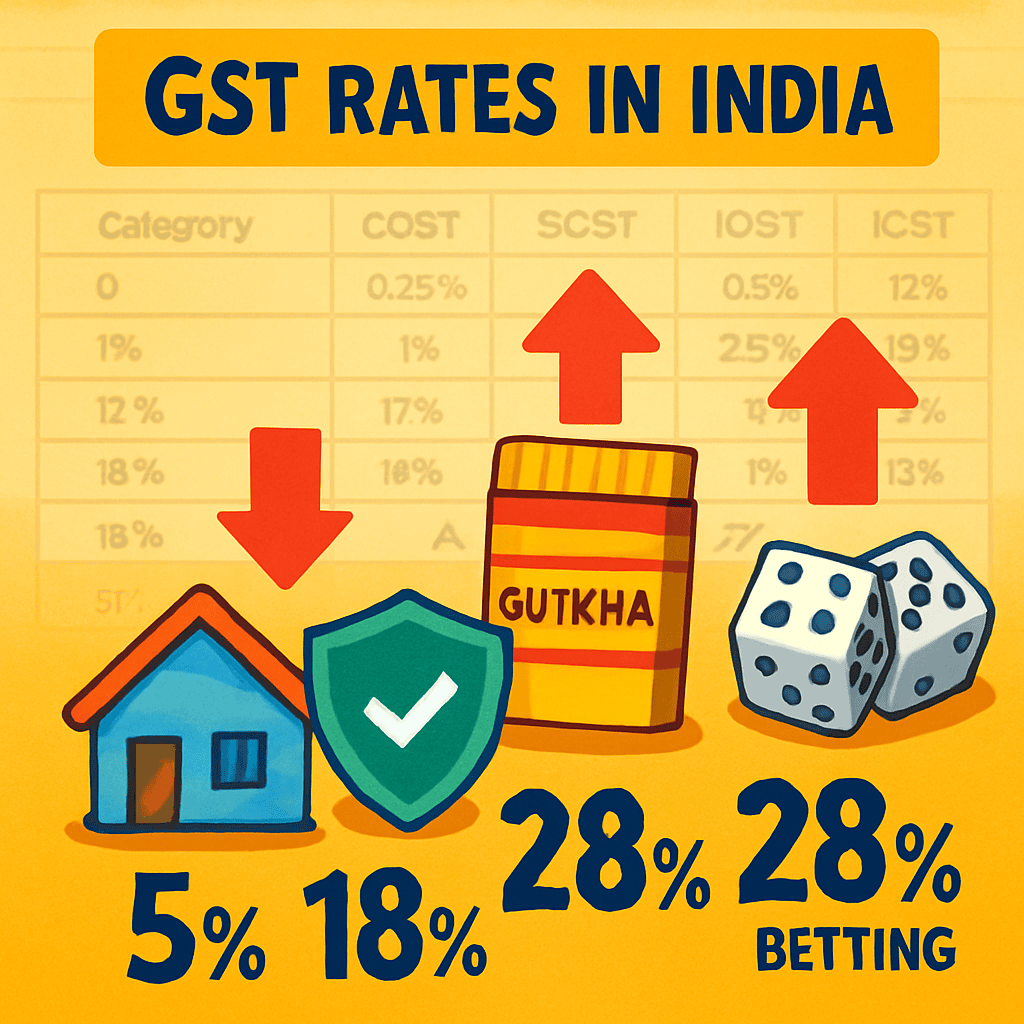The Goods and Services Tax (GST) has changed the way we pay taxes, but as rates undergo another round of rationalization in 2025, taxpayers wonder: What’s going to get cheaper, and what won’t?
This year’s expected changes show a clear trend — essentials and growth sectors are set to get relief, while harmful or luxury categories may face higher taxes.

1. Insurance at 5% – A Big Win for Families
Insurance is no longer a luxury — it’s a necessity. But high GST has kept many away.
Then: Around 18% GST made health & life insurance premiums feel expensive.
Now (Expected): Just 5% GST on premiums.
Impact in Simple Terms: A ₹10,000 policy will now cost you ₹10,500 instead of nearly ₹11,800 — saving your family ₹1,300 instantly.
Bigger Picture: More people will be insured, reducing crisis-time money problems and improving financial stability.
✅ Insurance becomes affordable, and financial security grows.
2. Cement at 18% – Affordable Homes & Stronger Infrastructure
Cement is the foundation of housing, roads, bridges, and India’s growth. But it has long carried 28% GST, which made construction expensive.
Then: 28% GST made homes and infrastructure costly.
Now (Expected): 18% GST.
Impact in Simple Terms: Building a ₹10 lakh house could see savings of ₹40,000–₹50,000.
Bigger Picture: Cheaper homes, boost to affordable housing projects, and a surge in construction jobs.
✅ Homes cheaper, jobs rise, infrastructure quicker.
3. Heavier Taxes on Harmful Products
Not everything should be cheaper. Harmful items are expected to see steep GST increases, even up to 500% more.
Gutkha & Tobacco: Higher prices will discourage use, reduce health problems, and save families from huge medical bills.
Online Betting & Gambling: Addictive apps and websites may get heavily taxed, limiting their lure for youngsters.
Impact in Simple Terms: Bad habits costlier, good habits rewarded.
Bigger Picture: Higher government revenue, healthier population.
4. Snapshot: Other Key Product Categories
Here’s where other goods & services may stand after GST changes:
| Category | Current GST | Expected After Cut/Change | Effect on You |
|---|---|---|---|
| Food essentials (grains, veg, milk) | 0% – 5% | No major change | No extra burden |
| Packaged food & snacks | 12% | Likely 5–12% | Everyday items a bit cheaper |
| Household items (paint, tiles, steel) | 18–28% | May reduce to 18% | Construction & renovation cheaper |
| Two-wheelers & small cars | 28% + cess | May see small cut | Budget vehicles slightly cheaper |
| Luxury cars, hotels, alcohol | 28%+ | Likely unchanged or higher | Remains expensive |
| Banking services (loans, fees) | 18% | May reduce to 12% | Reduced bank charges possible |
5. What It Means for You in Plain Words
Middle Class Families → Insurance will cost less, and building or buying a house will be easier.
Homebuyers & Real Estate Sector → Cement tax cut means a huge relief in construction costs and property prices.
Youth → While essentials get cheaper, addictive activities like betting and tobacco will pinch the pocket.
Government → May earn less from tax cuts on essentials but will balance it by taxing harmful items more
Final Thoughts: Balanced Relief with Responsibility
This mix of GST cuts and hikes shows a smart policy approach:
Essentials like insurance and housing inputs get cheaper → helping families and growth.
Harmful habits like gutkha and online betting get taxed harder → protecting health and society.
Everyday items get mild relief → keeping inflation in check.
👉 In simple terms:Good things will cost less. Bad habits will cost more. And India will move toward a fairer tax system.

